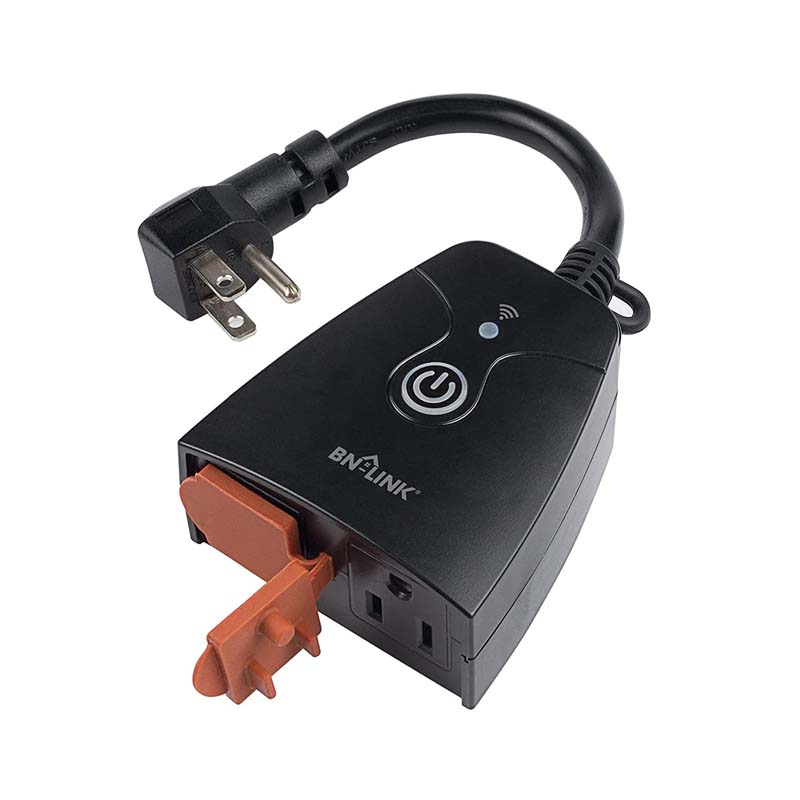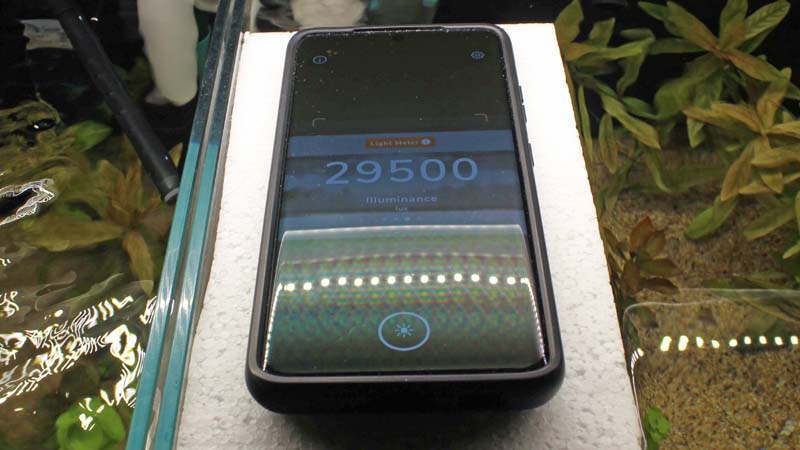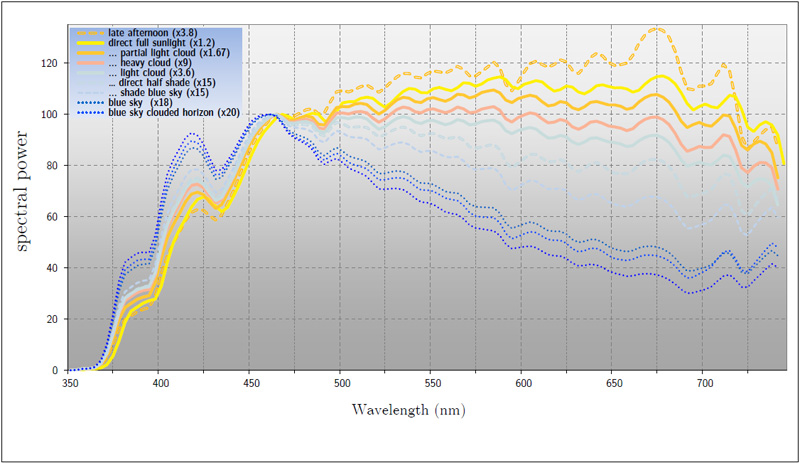Lighting
Lighting is very important to the health and growth of fish and plants. By far, the best light for the aquarium is natural sunlight. It isn't easy to match the intensity and color spectrum of natural sunlight. Systems that receive some sunlight often have excellent plant growth, and the plants will often stream oxygen bubbles while bathed in sunlight. The intensity of sunlight also intensifies the natural pigments of the animals.

There is a common aquarium myth about sunlight causing algae. In nature, aquatic plants are bathed in sunlight, and in unpolluted environments, excessive algae growth is not an issue.
As long as the hobbyist can keep the system from overheating from sunlight exposure, it is the best light source for maintaining a healthy aquarium. Planted aquariums that receive several hours of sunlight daily often have minimal algae growth.
Typically hobbyists keep aquariums indoors, so depending on placement in the home, they can receive a few hours of natural daylight a day. In most cases, aquariums end up positioned in the home where it receives no sunlight.
Planted aquarium hobbyists often want to saturate their systems with light to grow plants as quickly as possible. While lighting the entire aquarium may be optimal for plants, many of the animals we keep with plants prefer some shade. Hobbyists should consider the animals when lighting the system. Creating shade under submerged wood, rock structures, broad-leaf submerged plants, or an emersed canopy provides shade for animals. Another way to provide shade is to avoid lighting the entire surface.
A plant's growth and structure (height, diameter of stems, and size of leaves) can vary depending on the light source and position over the system. Some plants in aquariums that are not as brightly lit as others may respond by growing taller as a shade sense reaction. Some plants considered moderate light plants in the hobby may respond favorably to light with greater lux. Lighting systems are highly variable, and plant species can respond differently under systems with the same lumens, PAR, or lux.

WiFi timers (smart plugs) are a valuable tool to control the light duration of planted systems. The configuration of WiFi timer is done through a smartphone application and can manually be turned on and off through the app. A flat plug makes it easier to be plugged into a wall outlet behind a stand or aquarium.

The light spectrum (colors) is absorbed by water at different depths. Red light, which is very important to aquatic plants, is absorbed the quickest, almost all at 33 feet (10 meters). Much of the red light aquatic plants use cannot penetrate deeper than 15 feet (6 meters). For this reason, aquatic plants in nature in freshwater and marine environments are typically found at 10 feet (3 meters) or less depth.
Particulates and tannins affect how well light can penetrate the aquarium.
Glass tops can filter out some light. From personal testing, hobbyists should expect a 1/8 inch (3 mm) glass top to filter out about 3% of PAR. Glass-top aquariums significantly reduce evaporation and help keep jumping fish in the system. Glass-top aquariums are very capable of growing healthy aquatic plants.
Many planted aquarium hobbyists have open-top aquariums, but this comes with a trade-off. Open-top aquariums evaporate a lot of water, and fish can easily jump out.
Light-emitting diode (LED) lighting systems are the best way to illuminate modern aquatic systems. The efficiency and the light spectrum they produce are favorable to aquatic plants. There have been many advancements in LED lighting since they were new to the market. LED lighting systems today are more efficient, and the better systems include advances in horticulture light science in their arrays.
Indoor hydroponics is moving away from the traditional red and blue LED lights to full spectrum, as science has shown the benefits of full spectrum light. Studies have shown that UV-A light can benefit health, and far-red light can stimulate growth. The light spectrum, intensity, and duration all affect the growth rate, color, leaf structure, and stem structure. Blue photons can inhibit cell expansion, red photons are efficient at photosynthesis, and far-red photons enhance cell expansion. Research in photo-biology has shown that the benefit of a narrow blue light spectrum is amplified when another light from another spectral range is also available.
There are several ways light is measured:

Hobbyist can now install the Photone - Grow Light Meter application (previously named Korona) on their mobile device (iOS and Android) that measures PAR, DLI, lux, and kelvin. These tools allow the hobbyist to compare lights and analyze where in the system is the best plant placement.
A lumen (lm) is the light emitted from one candle. Lumens measure the total amount of visible light from a light source. The higher the lumen rating, the brighter the lamp will appear. Sunlight has about 10,000 lumens per square foot (30 cm x 30 cm).
One lumen per square meter equals one lux.
Lumens are a valuable metric that most light manufacturers provide to give the consumer an indication of how bright the light will look.
Lumens can be measured with the Photone - Grow Light Meter application.

Lux is a measure of illuminance (intensity), the total amount of light that falls on a surface. Lux can be measured with the Photone - Grow Light Meter application. Photometry uses lux to measure the intensity of light that hits or passes through a surface.
Direct sunlight can range from 32,000 to 100,000 lux. Shade can range from 10,000 to 25,000 lux. An overcast day is 1000 lux. Sunrise and sunset on a clear day is 400 lux.

Lux can be useful to planted aquarium hobbyists. By measuring the lux near the surface of the aquarium, the best light height off the surface can be ascertained. Lux can help maximize the amount of light hitting the surface.
The intensity of light fixtures quickly drops off depending on the reflector angle. A floodlight spreads the number of photons emitted over a broader area than a spotlight. Floodlights can be laid on top of the glass cover of an aquarium. A spotlight will need to be raised several inches off the surface to have the same amount of lux at the surface directly under the center of the light. For example, the author's 50-watt LED floodlight delivered 100,000 lux at 1 inch (2.5 cm) from the lamp, and the 23-watt spotlight produced 100,000 lux at 4.5 inches (11.5 cm). The spotlight focuses the photons into a smaller area.
Sometimes less lux has been shown to stimulate height growth in some plants.

The color rendering index (CRI) is measured as a number between 0 and 100. At zero (0), all colors look the same. A CRI of 100 shows the true colors of the object.
Typically, light sources with a CRI of 80 to 90 are regarded as good, and a CRI of 90 or more is excellent. The higher the CRI, the better the color rendering. High CRI LED lighting renders vibrant tones across the full-color spectrum. CRI is independent of color temperature.
A high CRI number does not quantify how well a lamp will grow plants, it is only useful as a visual appearance measurement.
Photosynthetically active radiation (PAR) is light of wavelengths 400-700 nanometers and is the portion of the light spectrum utilized by plants for photosynthesis. This spectral region corresponds with the range of visible light. Cyanobacteria can use light in the near-infrared.

Plant biologists often quantify PAR using the number of photons in the 400-700 nm range received by a surface for a specified time, known as Photosynthetic Photon Flux Density (PPFD). PAR, as described with photosynthetic photon flux (PPF), does not distinguish between different wavelengths in the 400 and 700 nm range, and postulates that wavelengths outside this range have zero photosynthetic action. PPF is micromoles per second (μmol·s-1). PPFD is PPF micromoles per square meter per second (μmol·m-2·s-1).
The most abundant plant pigment, chlorophyll, is most efficient in capturing red and blue light. Accessory pigments such as carotenes and xanthophylls harvest some green light and pass it on to the photosynthetic process, but enough green wavelengths are reflected to give leaves their color.
For years indoor horticulturalists have been using lighting systems that focus on the red and blue spectrum. More recent research on PAR has indoor horticulturalists switching to a broader spectrum lighting system. Research with plants in higher light concludes light quality may have a smaller effect on plant growth rate than light quantity.
PAR is the preferred metric to describe the quantity of light used for photosynthesis.
PAR values range from 0 to 3,000 micromoles (μmol) per square meter. During mid-day in the summer, PAR often reaches 2,000 to 3,000 micromoles per square meter. PAR meters are the most popular type of light sensor among plant biologists, horticulturists, ecologists, and other environmental scientists.
Most of the research done with PAR is with land plants. Research has shown a variance in color peaks, but red, blue, and green light is important for plants.
Using lights that focus on PAR above a display system often does not produce a blended color pleasing to the human eye. Many aquarium light manufacturers will provide a PAR value to compare.
PAR has its limitations as a measure of light. It only provides a total of micromoles of light wavelengths in the 400 to 700nm range and does not provide which wavelengths are producing a great number of photons. Lights with the same PAR rating can provide different results because of the spectrum peaks. High PAR is no guarantee of the results the hobbyist will see in their systems.
Lighting systems not marketed for the aquarium or horticulture do not typically provide PAR values but focus on kelvins, which provides a general guide of how the light it produces looks to the human eye and how bright the light will look in lumens.
More recent studies have shown the benefits of light in the UV-A range (below 400 nm to about 380 nm) and into the far-red range (above 700 nm to about 760 nm). This new data has been incorporated into a new range called Extended Photosynthetically Active Radiation (ePAR). Light meter manufacturers are now starting to produce sensors for ePAR.
PAR can be measured with the Photone - Grow Light Meter application. Many aquarium hobbyists have used the Apogee Instruments underwater sensors to measure the PAR or ePAR within their systems.
The daily light integral (DLI) is the number of photosynthetically active photons (photons in the PAR range) accumulated in a square meter over the course of a day. It is a function of photosynthetic light intensity and duration and is usually expressed as moles of light (mol photons) per square meter per day (mol·m-2·d-1). In nature, DLI ranges from 5 to 60 mol·m-2·d-1.
DLI is the most important light measurement growers of indoor plants can use. Most studies that measure DLI are done with terrestrial plants to optimize the number of photons a plant receives in 24 hours. Too many photons in a length of time and the vegetation begins to burn. Too little DLI and the plants rooting and growth will be slow. This metric is not commonly measured with aquariums. Aquarium hobbyists should consider measuring the DLI, especially when they have emerged plants.
DLI can be used to optimize lighting for aquariums also. DLI can affect the growth and color of submerged plants. Monitoring the DLI can help prevent leaf burning on emersed plants. Aquarium plant studies with DLI are lacking and, therefore, will require some experimentation by the hobbyist to develop optimal values for the species of plants that are kept.
The Photone - Grow Light Meter has a meter for collecting DLI data for your system.

Light spectrum is the many different wavelengths of energy produced by a light source. Light is measured in nanometers (nm). Visible light is in the spectrum from 380nm to 780nm.

The ratio of light color in the PAR spectrum and its lux can affect the size and shape of plants.
Spectroradiometers measure the brightness and color (chromaticity) of a light source. Spectral data is used to create a spectral power distribution (SPD), a graphical representation of the energy and wavelength properties of the source light. The y-axis is typically normalized on a scale from 0 -1, indicating relative power at each wavelength, not absolute unit measurements.

Spectroradiometers are typically used in manufacturing and research labs. The cost of spectroradiometers makes them less attractive as hobbyists' test equipment.
Kelvin is used to measure the color temperature of light sources. In the aquarium hobby, kelvin is used to gauge how the light color will look on the system. Kevin is the blending of colors in the viable spectrum, and the result is how humans perceive the color. Another way to express it is the cosmetic look of the light. Temperatures at 4000K appear yellow, 5000 to 6000K is close to natural sunlight at mid-day, and 6500K appears bluish-white.
5000 to 6000K light will typically provide the most natural-looking light and present the plant and fish colors in the most pleasing colors. Above 6000K, the light will look bluer as the blue spectrum is more emphasized. Excessive blue light can make plants look yellow, red pigments look black, and blue pigments pop.
Kelvin can be measured with the Photone - Grow Light Meter application.

LED parabolic aluminized reflector (PAR) is a metric used with spotlight bulbs. The 20 to 38 size after PAR is the diameter measured in eighths of an inch. A 2.5-inch diameter means the light is 20 eights of an inch which is expressed as PAR20.
Spotlight lamps offer strong, focused, and a narrow directional beam of light. Spotlight bulbs are available in various sizes, most between PAR20 to PAR38. Most LED PAR spotlight bulbs are between 30-45 degree beam angles, but 120 degrees are also available. The bulbs come in many watt ratings. Spotlights are also sometimes called floodlights.
Hobbyists can find spotlight bulbs in 5000K and 6000K with a CRI of 90 or more. Many Spotlight bulbs do not provide CRI values. Some spotlights can produce more than 5000 lumens.
The focused light from a spotlight requires it to be hung or mounted higher than most fixtures. The narrow beam changes light refraction when the water's surface is agitated. Refraction can focus photons into a narrow beam, providing a shimmering effect through the system. Spotlights create shaded areas under tall, broad-leaf plants and decor. The lux and PAR will be highest directly under the light. Centering plants that require high light under a spotlight will yield the best growth.
A personal independent test (using the Photone App on an Android phone) of a PAR38 23-watt spotlight measured at a distance of 9.5 inches (24 cm) produced 545 PAR, 30000 Lux, 5950 kelvin, and 23.3 12h DLI.
Floodlights are an excellent option for systems with glass tops. Floodlights allow the hobbyist to set it on top of glass lids for easy installation. The LED spacing in the arrays of floodlights can vary. If you value the sunlight shimmer effect in your system, look for a tight LED array in the fixture. Floodlights are commonly available in 5000K and 6000K. Floodlight manufacturers typically do not provide CRI or PAR, but do provide kelvin and lumens.
Floodlights create shaded areas under tall, broad-leaf plants and decor. The lux and PAR will be highest directly under the light. Centering plants that require high light under a spotlight will yield the best growth.
One 50w LED floodlight can cover a 24-inch (60 cm) by 24-inch (60 cm) area. The floodlight's 120° angle provides excellent coverage for systems 24 inches (60 cm) in height. Aquariums 12 inches (30 cm) in height may need to have the light suspended for more uniform coverage.
A personal independent test (using the Photone App on an Android phone) of a 50-watt floodlight measured at a distance of 1 inch (2.5 cm) produced 2140 PAR, 114000 Lux, 6350 kelvin, and 111.9 12h DLI.
LED light bars (stoplights) spread light out over the surface of the aquarium. These lighting systems provide light in a more uniform distribution, with fewer shaded areas. Hobbyists with Dutch-style (multiple stem plant species) planted aquariums often prefer light bars.
A personal independent test (using the Photone App on an Android phone) of a 4-foot 85-watt shop light measured at a distance of 5.75 inches (14.6 cm) produced 539 PAR, 29600 Lux, 5250 kelvin, and 22.5 12h DLI.